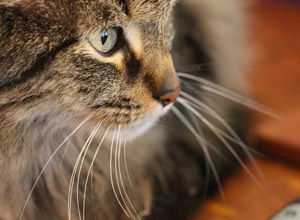cat whiskers Oursler

Photo by Dr. Teri Ann Oursler
When you walk in the dark, you may put your hands on the wall to guide you so you don't stub your toe on it. That's because human whiskers are pretty much useless except to help
prevent sunburn and melanoma.
In the animal kingdom, the far more sensitive whiskers called vibrissae provide in-the-moment benefits, such as knowing how far you are from the wall, the prey, or the danger. Trifocals aside, humans have far better eyesight than animals, so for the most part we can see what we're sticking our face into or where our dinner is. We don't need vibrissae. Vibrissae are particularly useful to animals that navigate in dim light. These tactile hairs are exquisitely sensitive to vibrations in the air or water, and send a message to the brain about the animal's distance from a given object. Vibrations, vibrissae - get it? Isn't etymology awesome? We're talk about the original good vibrations.
You can easily see them on the side of your pet's face, like a man's beard, or above their eyes, like eyelashes. If you look carefully under the chin, you'll likely see some sticking out like sunflowers from an area of thick skin. Most species have these lovely beauties - mice, foxes, fish, bunnies, chinchillas, walruses, horses, even some birds. Thanks to the vibrissae, the animal does not have to make physical contact with a surface to know it is there.
Growing evidence shows that northern elephant seals - the big honkin' guys with vibrissae moustaches - use theirs to locate prey. They have five to eight times more vibrissae than animals that only walk on land. It's like having a moustache with a built-in global positioning system. Although seals can see in deep water, it's likely somewhat limited. Photographs of foraging northern elephant seals show that their moustaches, technically called mystacial vibrissae, extend forward before they capture prey. Harbor seals can follow water trails using their vibrissae; they are highly sensitive to water velocity changes. Seals have the largest vibrissae among mammals.
When the air moves, either from the wind or the furnace, your pet's vibrissae vibrate to send a message to the brain: You are X distance away from something; after moving another inch toward your goal, you know you're even closer. Vibrissae function as a guide when your dog is moving between bedrooms at night to check on the kids and your cat is tossing stuff off the kitchen counter for fun or earning his keep with rodent control. Mice and rats use them to follow along walls. It's only fair.
Vibrissae really help if a pet is losing vision. That’s why the vibrissae are there: dogs or cats can tell what’s happening all around their face without needing to use their eyes. Spatial awareness allows more confident movement at any time, but particularly when vision is decreasing.
They work because they're designed to be sensitive.
Walrus face Bigstock

Safety tip: Don't play around with them. Don't even touch them. Vibrissae are heavily supplied with nerves - sensitivity is their whole reason for being - so if they touch something or the wind blows on them, their brain will know it. You definitely don’t want to rub them against their natural direction because that would feel like being pinched. Your nerve-filled fingertips are more sensitive than your forearm, and it's the same idea for your pet as vibrissae respond to the slightest touch. Plus, there is some anecdotal evidence that messing around with them lowers the pet's spatial awareness. It's no surprise that cats resent having their whiskers manhandled!
Fight any instinct you have to pluck them out...ow ow ow! The hairs grow in mounds of nerves. It's not like stripping a terrier's wire coat. If you pull one out like a weed, a vibrissae will bleed and bleed. The roots are in hair follicles filled with blood vessels and nerves; they’re also called blood hairs for a reason. If you are grooming a dog, only clip in the direction of hair growth. They will grow back slowly. Your dog won’t enjoy having vibrissae trimmed, but at least trimming can be done without inflicting pain.
If you happened to have searched the topic with Dr. Google, forget the ill-advised advice to never, ever remove them. Let's blow this abysmal myth out of the water: Vibrissae are not attached to the brain in some unusual way. The Internet has too many false "facts" and this mystical connection is one of them. There are some times when it is medically wise and even necessary to remove whiskers, so don't worry if it happens to your pet. One example is if a cat has an abscess that is adjacent to the vibrissae rupture (ow) (ow ow ow!). Let's say the base of the vibrissae gets covered up by the organic material in the abscess (that's when stinky pus explodes like an alien coming out of Sigourney Weaver's chest) and by the time the veterinarian sees the cat, the organic stuff is deeply matted into the base. The veterinarian may need to remove them in order to treat the burst abscess/alien properly. When that happens, the cat is sedated. No professional in their right mind does a procedure on a cat's blown-up face without sedation or anesthesia, even if it's nowhere near vibrissae. A veterinarian might also need to cut them if there is there has been some facial trauma, like when the dog uses his face to urge that car away from his house ("Get along, little Buick").
Outside of medical treatment, however, there is no physical reason to remove them, but some people do trim them before conformation shows.
If a whisker breaks in half - perhaps your dog stuck his face into the fridge door while it was closing - it will grow back slowly. Very, very slowly at the speed of a turtle with a broken leg. Starting out for the day at the crack of noon kind of thing. It has to wait for the next shed cycle to even start regrowing. Like other hair, they just fall out at some point so it's normal to find one lying around the house now and again.
Vibrissae aren't just receptors, either. You may have noticed that if your dog perceives a threat (oh, those evil nuthin's!) they will stick straight out. On guard! When your kitty is relaxed, the whiskers are pointed away and lightly curved, not stiff across the face pointing in all directions. Kitties are rarely afraid, right? You can tell what kind of mood your companion animal is in by looking at their whiskers. Just like our eyelashes and eyebrows, vibrissae have a biological function. Our eyebrows help keep sweat out of our eyes, and eyelashes protect our eyes from dust and other debris. Vibrissae signal concern about a potential predator, and help navigate in dim light, plus - more for our benefit than theirs - whiskers make our pets look even cuter than they already are. Talk about a win-win!
2 Comments
Laura Hedden
February 1, 2017
Melanie Moore
January 31, 2017